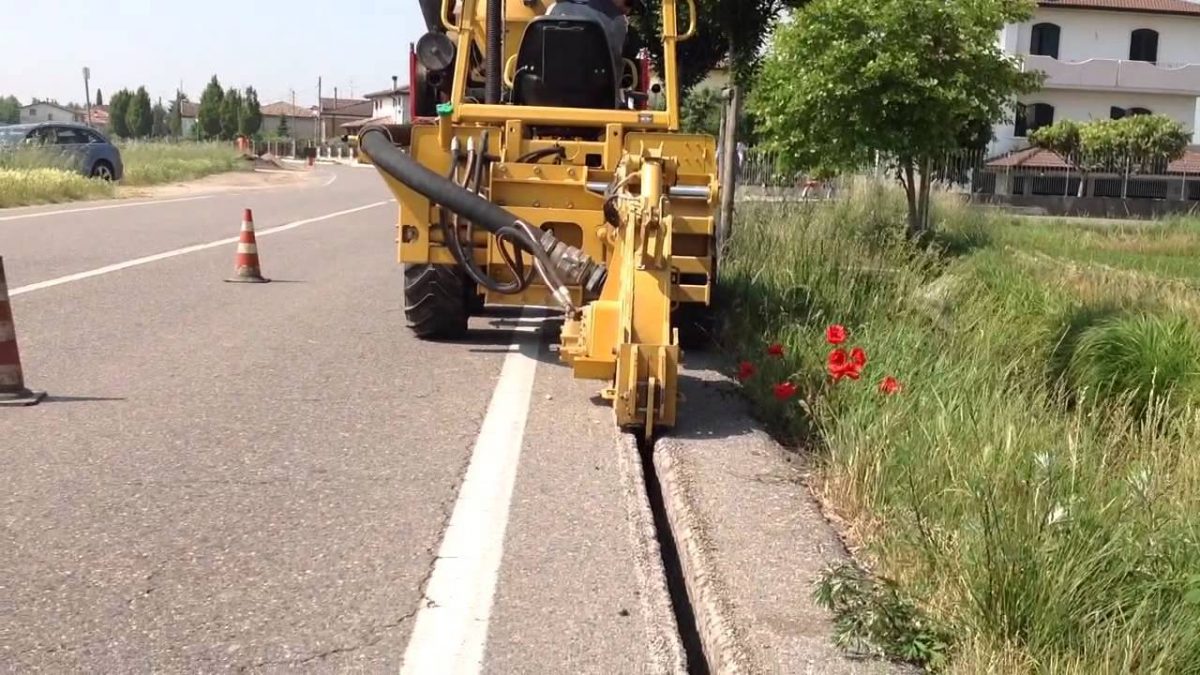- Mail:
- info@digital4pro.com
Ultra-Wide Band: the mini trench

Banda Ultra Larga: la minitrincea
9 Giugno 2020
Il fattore umano e l’importanza della Cyber Security Awareness
10 Giugno 2020For the diffusion of the Ultra-Wide Band over the territory, both through xDSL1 and 5G technologies, it is essential for telecommunication operators to use minimally invasive, fast and cheap laying techniques.
The mini-trench technique, alongside that of the Controlled Horizontal Drilling that we have already seen 2, is used to create telecommunications infrastructures by resorting to a solution that involves the excavation phases of a trench of reduced dimensions (width from 6 to 10 centimeters and depth from 25 to 40 centimeters), the laying of the infrastructure and the filling of the excavation integrated in a single operation.

Figura 1 – Cantiere di lavoro con la macchina operatrice in fase di scavo.
The miniaturization of the excavations and all the other components of the networks with the adoption of micro-cables and microtubes for the construction of the broadband networks are now, as well as an alternative for operators who find it attractive to limit the costs of building the network and to dilute them over time according to the actual growth in demand, also a real need of the managing bodies of the grounds which, due to the presence of different operators, find themselves managing and coordinating capillary excavation works on the territory, with dimensions exaggerated, with slow progress of construction and construction sites invasive and annoying for the inhabitants.
Advantages
This technique is aimed at:
- Eliminating waiting times between excavation, laying of jacket pipes for subsequent cable insertion and filling of the trench
- Minimizing the invasiveness of the excavation in the structure of the existing road substrate which is affected to a minimum extent without in any case undermining its characteristics of durability and resistance over time as it occurs using traditional excavations.
- Reducing the social impact of the work site which is small in size, with daily advances of a few hundred meters per day (up to 3-400 meters in peripheral neighborhoods or outside inhabited areas) and with minimal inconvenience to road traffic.
- Reducing the environmental impact as it produces extremely small quantities of waste materials (about 1 m3 per 50 meters of excavation) to be transported to landfills.
The mini-trench technique is the most advantageous for the connection between inhabited centers in an access area, and sometimes also in particular areas, such as production areas, taking into account any interference with the other underground services and avoiding installations above and parallel to one of these, in order to allow maintenance interventions without removing the telecommunication cable. This problem must be limited in the planning stage since traditional underground services are normally built at least one meter from the roadside, while the mini-trench is built on the roadside. Interference is therefore usually orthogonal.
Limitations
The mini-trench technique sees its limit of use in the presence of numerous services at depths less than that of excavation (40 cm) or with overly tortuous paths with numerous directional variations at 90 ° and with radii of curvature of less than 8 meters. In both of the conditions mentioned, the jobs are still possible but involve repositioning the machine with the suspension of the work in automatic mode and therefore a reduction of the advantages in economic terms.
Another case, however rare now, in which the system becomes less competitive is the one in which the infrastructure to be built has dimensions greater than the capacity of the excavation performed. Adopting this technique it is in fact advisable not to exceed 10 cm in width because, if the excavation is wider, the depth must consequently also grow in order not to incur problems of stability of the infrastructure due to the load of the traffic above. This double increase in the dimensions of the excavation makes the volume of material removed excessive, partially nullifying the advantages that were wanted with the miniaturization of the excavation.
1 The Digital Subscriber Line (DSL) is a family of technologies used to transmit digital data on telephone lines.
2 https://www.digital4pro.com/2020/03/24/banda-ultra-larga-la-trivellazione-orizzontale-controllata/




